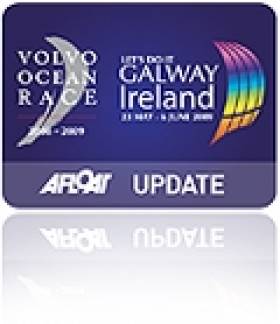Displaying items by tag: David Branigan
Howth's Maritime & Sailing History is Brought Centre Stage
#hyc – A new billboard on Howth Yacht Club's prominent gable wall has re-kindled local and general interest in the Fingal port's place in Irish and international sailing and maritime history. And it has led to an upsurge of warm local pride around Howth Harbour. After a summer visiting other ports, W M Nixon returns home and tells how it all came about, and of the re-vitalised seaborn sport which has resulted from this imaginative initiative.
The world's most historically interesting and best-preserved one design keelboat class is hidden in plain sight just 14 kilometres from the heart of Dublin. And at the entrance to the harbour where these very significant boats have their secret summer existence, there stands the most perfect little classic lighthouse you ever saw. It too is hidden in full view.
Or at least, it all seems virtually invisible for many of the folk who live in Howth, who have simply become so accustomed to the presence of the 1817-built lighthouse and the 1898-founded Howth Seventeen Class that they scarcely appear to notice them any more. They seem to take them for granted, as is the case many of the other special features of what is a remarkably successful fishing and sailing port.
Well, maybe they do take a little bit of notice. Certainly if some environment-altering project gets under way which doesn't meet with quiet general approval, you'd be surprised by the level of opposition which can be aroused, and with effect too. But it's part of Howth's reserved way of doing and seeing things not to make a song and dance about local features of importance and attraction when they are as they should be. For it is a fact that, well within living memory, Howth most certainly didn't exude prosperity. So the ingrained pessimism of a fishing port means that when things are going well and the place is functioning as it should, you just stay quiet and don't make a song and dance about the good times rolling.
Nevertheless, now and again when someone with experience of the outside world, and the standing to have opinions which matter, says that Howth is very special and it's time somebody said so, we're quietly rather pleased. And when it's done in in a way which has the style and effect of the new Mercedes-Benz billboard on the prominent gable wall of Howth Yacht Club, we're very pleased indeed.
This billboard encapsulates much that it is significant in the history of Howth Harbour, and it gets the spirit of the place. It shows four boats of the Howth Seventeen class (the "17" refers to their waterline length) gliding in close formation under their full jackyard tops'l rig into the harbour past the gem of a lighthouse in a photo which is so pin sharp that you can easily read the date plate of 1817 on the lighthouse.
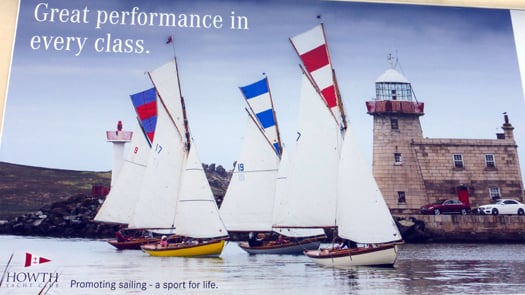
The Howth Seventeens which made it to stardom are (left to right) Hera (Michael Duffy0, Oona (Peter Courtney), Isobel (Brian & Conor Turvey) and Aura (Ian Malcolm) Photo of David Branigan photo by W M Nixon
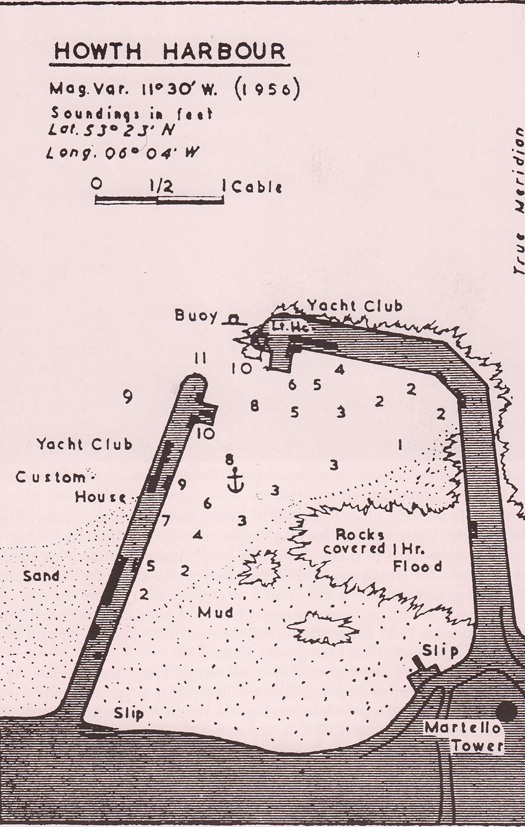
Howth was a distinctly disadvantaged port until relatively recently. Used as the main Dublin ferry port only between 1817 and 1826 (when Dun Laoghaire took over), it only became a "fishing station" around the 1840s-1850s. Then when the herring were fished out by the 1890s, some recreational boating space became available. But even by the late 1950s, as seen here, it was still a very limited harbour.
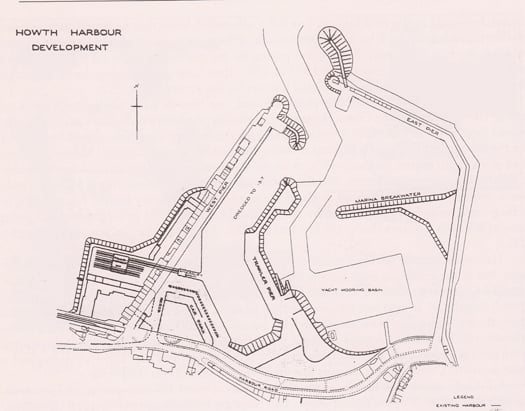
This outline plans for a major Howth redevelopment became available in the late 1970s. In those days, the very idea of a marina was anathema to some interests. So although a new breakwater is indicated as the "Marina Breakwater", the actual space in which Howth YC were to be obliged to install a marina at their own expense was only referred to as a "Yacht Mooring Basin".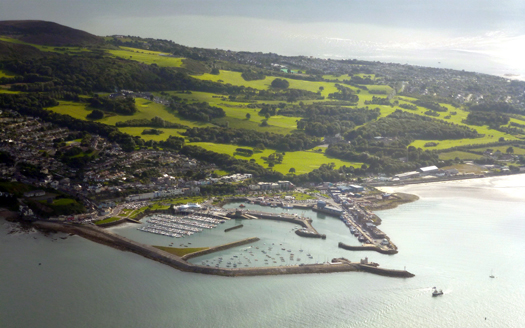
Howth Harbour as it is today, looking southwest across the peninsula with the waters of Dublin Bay at Sutton at top of photo. With clearcut boundaries between the different harbour uses, it has become a harmonious place. The presence of an active fishing port has led to a proliferation of good seafood restaurants. And the preservation of swinging moorings in the northeast corner of the harbour (foreground) has enabled the historic Howth 17s to survive and prosper. Photo: W M Nixon
The Howth Seventeens are part of Irish and international sailing lore. They still sail to the original design by Herbert Boyd of Howth House as signed off in October 1897, and they still race as keenly as they first did on May 4th 1898. More keenly, in fact - they currently have something like sixty races a year, and new boats and new owners and crews have lately been joining the fleet.
As to how they have acquired this overnight fame after 116 years, it's down to Stephen O'Flaherty of Mercedes-Benz. He brought together the needs of Howth YC for a sponsor for their Autumn League in concert with the fact that his quality marque sought a happy match with something which allied classic and timeless style, and could withstand the prolonged exposure of being on a highly visible billboard for the three years of the contract.
Working in close consultation with former and present HYC Commodores Derek Bothwell and Brian Turvey, the idea developed of a big screen photo which would encapsulate key aspects of Howth's unique maritime features in a clear and eloquent combination. Stephen O'Flaherty is owner of the achingly handsome Spirit 54 Soufriere, so he has an eye for a good-looking boat. And as a relative newcomer to being a Howth peninsula resident, he still sees it all afresh.
He pointed out that the little lighthouse at the end of the East Pier is still beautifully maintained, though it is now redundant as the working lighthouse is further north on the breakwater extension added in the early 1980s. Indeed, it is still even inhabited, and for many folk from elsewhere, that plucky little historic lighthouse symbolizes the spirit of Howth. It looks just as a lighthouse should, and it provides a perfect background for a sailing scene featuring the Howth 17s.
So all that was needed was a suitable day to get ace marine photographer David Branigan of Dun Laoghaire (who showed at last year's J/24 Worlds in Howth that he has a talent for drawing the locals' attention to the more picturesque aspects of their port and peninsula), line up half a dozen well-presented Howth Seventeens complete unto jackyard tops'ls, and get them in a harmonious arrangement with the lighthouse in the background and the flanks of the steep island of Ireland's Eye beyond, and lo and behold you have your magic picture, just like that.
Anyone who has ever tried to take a photo of just one boat sailing will realize what an extraordinary challenge this was, as even with one boat you're relying on the presence of a breeze, you're hoping for sunshine, and you're praying that when the best moment arrives, nobody will be standing up on deck or in the cockpit, or looking at the camera, thereby ruining the balance of the photo. And that's just with one boat.
Worse still, it all had to be brought together at very short notice. But the first day suggested for a photo shoot – Thursday August 28th and already under pressure with just two weeks and a couple of days to go to the start of the Autumn League – was a complete no-go with adverse conditions. Time was running out. It had to be Monday September 1st.
They had neither decent breeze nor sunshine on the day, and getting the Howth Seventeens to sail in concert is about as easy as herding cats. As for the wind, it was only fitful from the east, while to the inexperienced eye, the light seemed very flat, and no sunshine.
On top of that, team head Joanna Kavanagh of MSL had only been available on the Thursday – by Monday she was on another photo shoot in Portugal. But far from letting this get them down, the location team rose to the challenge. And the Howth Seventeen sailors gave of their best for a whole day. Show me a Howth Seventeen sailor, and I'll show you a ham......
In the cruel ways of Tinseltown, of the six Howth Seventeens which gave of their very best for that long and often frustrating day's shooting, two ended up on the cutting-room floor - Roddy Cooper's Leila and the Nick Massey syndicate's Deilginis. The final masterful Branigan photo shows Ian Malcolm's Aura (no 7) ahead of Peter Courtney's Oona (no 17), Conor and Brian Turvey's Isobel (no 19) and Michael Duffy's Hera (no 9).
As a sailing photo, it mightn't garner enough excitement to make it into a yachting magazine. But as a billboard designed to tell a story in a specific location, it tells ten thousand words, and tells them very well too. And as clearly as possible – Jason Hurley of Jason Hurley Designs, who was involved in the shoot, also cleaned up the raw photo afterwards to enhance it and take out stains from sails, scrapes from topsides, and weed from waterlines. When it went up just three days before the Autumn League was due to start on Saturday September 13th, it was to be greeted with a shared wave of enthusiasm of a kind which is rare enough in a quirky little community like Howth.
Needless to say, there were soon the usual quips to be heard. The Howth Seventeens survive through turning the laws of physics on their heads. Thus while energy creates friction for other folk, among Seventeen-footer persons it's friction which creates energy. There's nothing like a barbed remark or two to sharpen enthusiasm for the next race. So for those who have said that it takes a posed billboard photo to ensure that Ian Malcolm with Aura will be at the head of the fleet, let me say that in addition to winning races now and again, nobody else in the class has done as much to tell the world that the Howth Seventeens are alive and well and sailing more keenly than ever, and here's a selection of just some of the things that Aura has done in the last sixteen years:
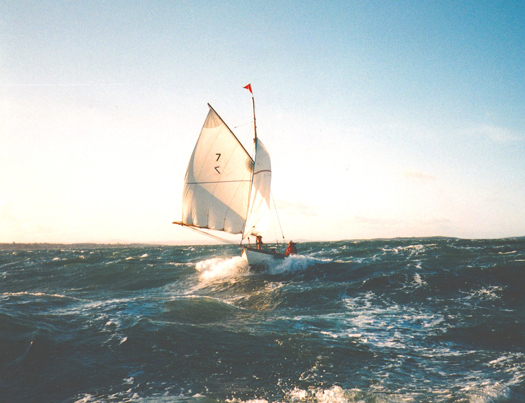
Aura goes offshore. In 1998, the Howth 17s celebrated the Centenary of their inaugural voyage from builder John Hilditch of Carrickfergus 95 miles non-stop back to Howth. Aura is seen here starting to get offshore off the County Down coast as a bright but very cold evening draws in on April 15th 1998. Photo: Damian Cronin
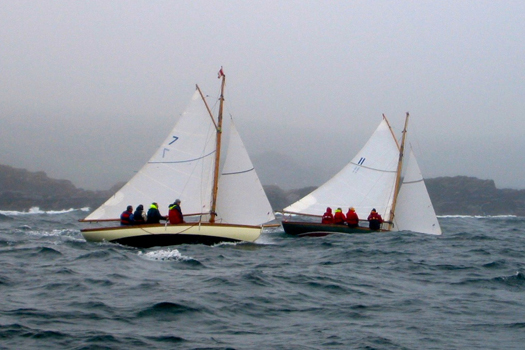 The Howth 17s make the scene at the Glandore Classics 2003 with a foggy race from Castlehaven to Glandore. Here, Aura is chasing Deilginis close inshore. The winner was the first boat to have a crewman downing a pint in Casey's bar in Glandore. Photo: W M Nixon
The Howth 17s make the scene at the Glandore Classics 2003 with a foggy race from Castlehaven to Glandore. Here, Aura is chasing Deilginis close inshore. The winner was the first boat to have a crewman downing a pint in Casey's bar in Glandore. Photo: W M Nixon
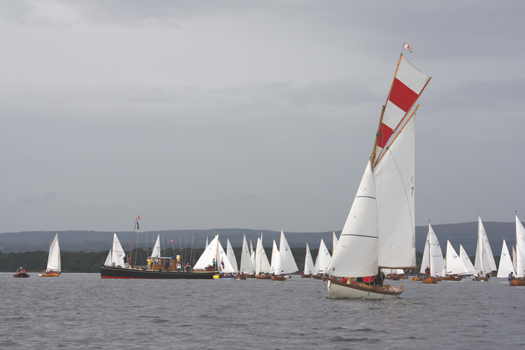
In 2008, Aura was the only Howth 17 to take part in the Waterways Ireland Classic Boat Regatta at Dromineer on Lough Derg. She is seen here sharing the lake with an International 12, Water Wags, Shannon One Designs and a Folkboat together with the 1873-built committee boat Phoenix (John & Sandra Lefroy). It was the first time a jackyard tops'l had been seen on Lough Derg since before the Great War of 1914-18, as the post-war fleet there were either gunter or Bermuda rigged. Photo: Gerardine Wisdom
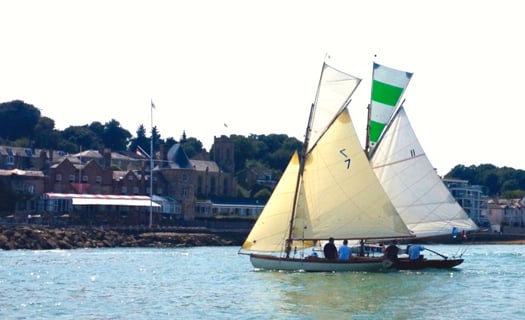
Aura and Deilginis off the Royal Yacht Squadron Castle at Cowes in July 2013 during the Classic One Designs Regatta. It is thought to be the first time the Howth 17s were in the Solent. Photo: Mel Massey
As to the Howth Autumn league, it started 35 years ago in a low key sort of way, when the boats of the newly-formed Squib Class realized they'd been at full first season fleet numbers for only a few weeks, yet if they followed the local wooden-boat traditions, they'd soon be laying up. But the Squib is a minimal maintenance little 19ft keelboat, most of the boats were new in any case, and the Lasers had been having their annual winter series in Howth since October 1974. So the Squibs decided to tag themselves on to the Laser race officer team, and continue their sailing until early December, and thus was the Howth Autumn League born, though it didn't become a fully-fledged all-keelboat-classes business until the marina opened in 1982.
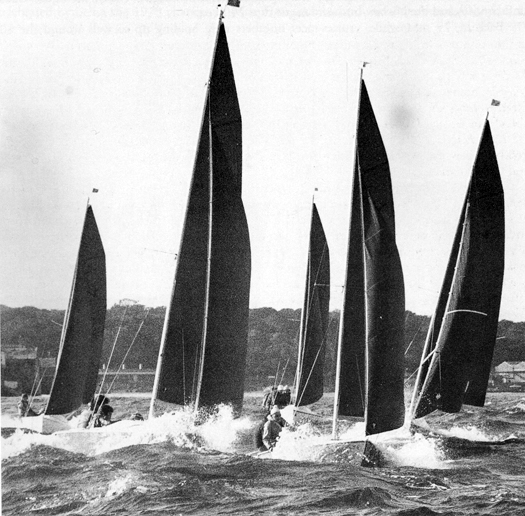 When it all started. The newly-established Squib Class inaugurated the Howth Autumn League in 1979, and this was the first race of that series. Photo: Jamie Blandford
When it all started. The newly-established Squib Class inaugurated the Howth Autumn League in 1979, and this was the first race of that series. Photo: Jamie Blandford
Underlying all this, the Howth Winter Lasers will be celebrating their 40th Anniversary. And it also means that HYC have had a continuous sailing programme since their Opening Day in April 1974. But last weekend the first race of the Mercedes-Benz Autumn League 2014 was enough to be going on with, sailed to mark the new sponsorship and the 35th anniversary of the inaugural Autumn League. And as I was one of those mad keen little Squib skippers 35 years ago, it was an ideal opportunity to take up an invitation to race on Soufriere and mark it all with a bit of style.
She has been having a good year on the race courses. Stephen O'Flaherty has teamed up with David Cagney to bring that wayward sailing genius into his regular crew, and while you wouldn't dream of calling them the Odd Couple, the phrase springs irresistibly to mind. They have raised Soufriere's racing to a new level, with an excellent win in the long inshore race at the Panerai Classics at Cowes in July, and then last month they found a new level of joint success with an extremely good debut in Two-Handed racing in the Aqua Double-Hander at Howth, leading a fleet of 34 boats on the water and on corrected time for much of the race round Lambay and the Kish and back to Howth Harbour, only slipping to a close second overall through being becalmed for a couple of minutes just yards short of the finish line.
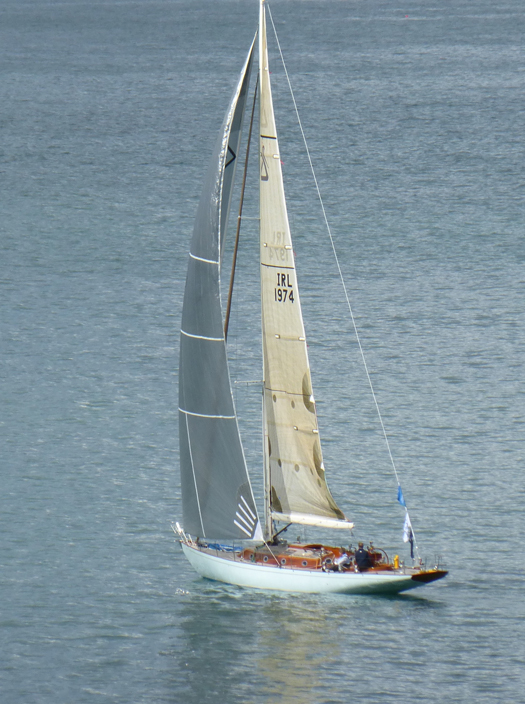 Soufriere approaching the finish of the Aqua Double-Hander at Howth in August, when she would have won overall on both handicaps had she not been becalmed for four minutes within yards of the line. That race-winning headsail may look gossamer light, but on a 54-footer it weighs around 40 kilos, and it's quite a haul for a two man crew to get it aloft. Photo: W M Nixon
Soufriere approaching the finish of the Aqua Double-Hander at Howth in August, when she would have won overall on both handicaps had she not been becalmed for four minutes within yards of the line. That race-winning headsail may look gossamer light, but on a 54-footer it weighs around 40 kilos, and it's quite a haul for a two man crew to get it aloft. Photo: W M Nixon
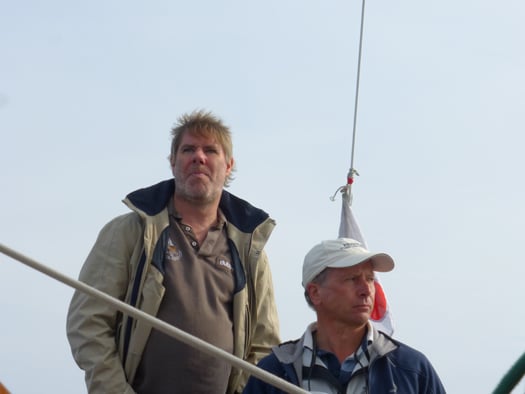
A penny for your thoughts....David Cagney and Stephen O'Flaherty pondering the options for Soufriere when their just isn't enough wind to get the big lady moving properly. Photo: W M Nixon
Many folk would think it absurd to race a "new classic" like Soufriere against the likes of our opposition last Saturday, as it included Nobby Reilly and Alan Chambers' Mills 36 Crazy Horse, and the Kelly team's J/109 Storm which is always there or thereabouts in ICRA Racing, and has been ICRA Boat of the Year in her time. But Soufriere has a modern underwater profile of vertical bulb keel and spade rudder, and despite her very attractive wood construction in edge-glued strip planking, her all-up weight is only about nine tons.
Nevertheless, she does have to cart about these elegant long ends, which are only an asset for extra speed when the wind is above a certain strength. To add to the challenge, the ideal minimum wind varies, dependent on which point of sailing you're on. Beating, she seems to come to life in as little as 6 knots real wind speed. Reaching, you need about 8 knots. But downwind, she's sticky until it's getting near 10 knots, and preferably more.
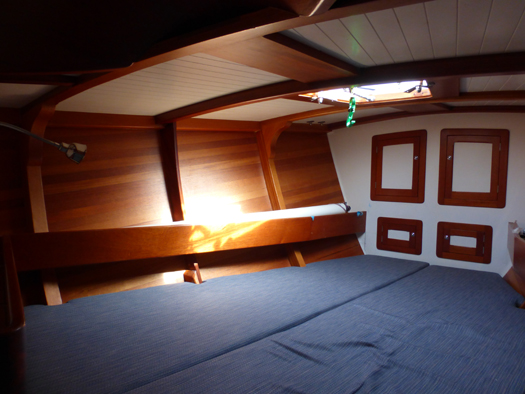
The forward cabin shows the Spirit style. With the wooden hull unlined, the noise of the water going past is pleasantly distinctive. Photo: W M Nixon
As to the impression on going on board, you have to think of Soufriere as they do with the Howth Seventeens, in terms of her waterline length. She certainly doesn't have anything like the accommodation of a standard modern 54 footer, and even her waterline length of 12m (39ft 8ins) suggests more room than there is, as her beam is only 3.3m (10ft 10ins). But within that, the accommodation is welcoming and elegant, and the boat gives out very pleasant vibes, as she is immaculately maintained by Tim Foley of Dun Laoghaire.
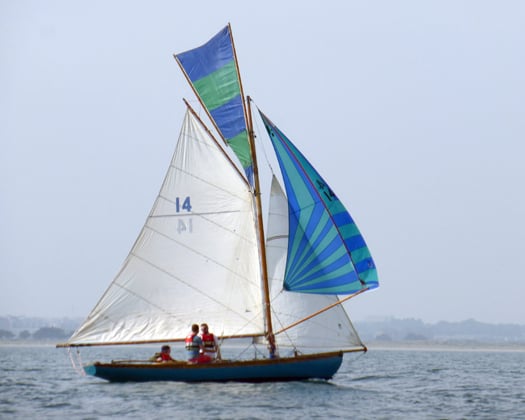
Back in harness. Aidan MacManus of the King Sitric Restaurant has re-joined the Howth 17s by buying the Howth 17 Gladys in partnership with Kieran jameson and others. He first bought Gladys in 1974, and is the first helmsman to have won a race in the Seventeens with 16 other boats astern. Photo: W M Nixon
Going out for the that first race of the re-vitalised Autumn League last Saturday, we motored quietly along past noted restaurateur Aidan MacManus in his Howth 17 Gladys, which he has re-bought in partnership with Kieran Jameson and others. Aidan first bought Gladys in 1974, and he is written permanently into the class's history as in 1988 he was the first skipper ever to win a Howth 17 race with 16 other boats behind, for in a class of such great age, it's seldom that any season will see all the boats afloat.
The wind was light easterly on a day which belied it was mid-September, shirt sleeves stuff and careful reading of summery conditions which were too light for Soufriere. But the team gave it their best shot, and when there was occasionally that essential little bite to the breeze, suddenly we were at the races.
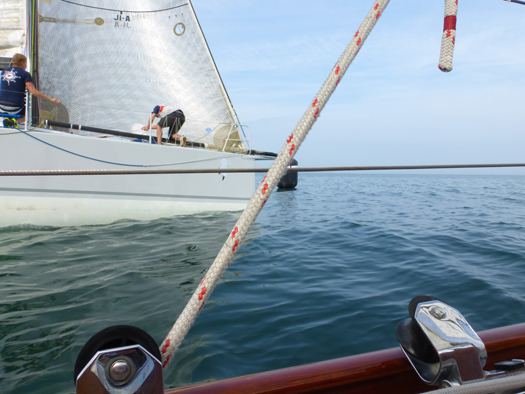
Reaching the weather mark neck-and-neck with Crazy Horse but miraculous to tell.......... Photo: W M Nixon
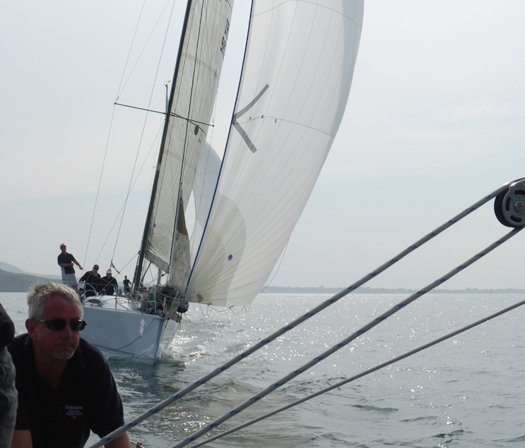
....on the reach Soufriere found her groove and the Horse was soon put astern......Photo: W M Nixon
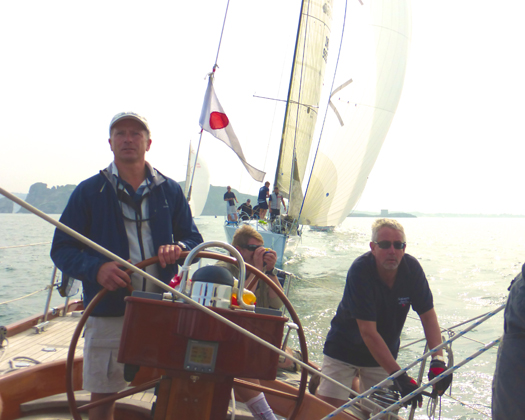
.....and for as long as we were on the reach, we were lengthening away......Photo: W M Nixon
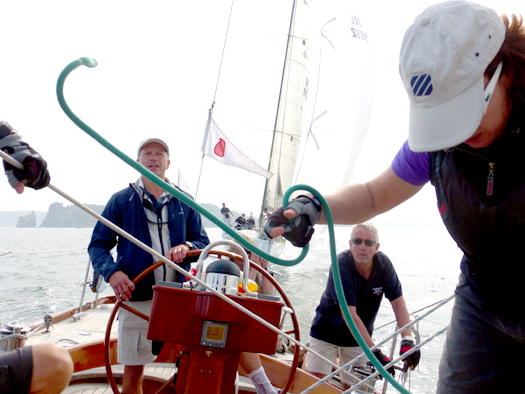
.....while the crew prepared for the run. Photo: W M Nixon
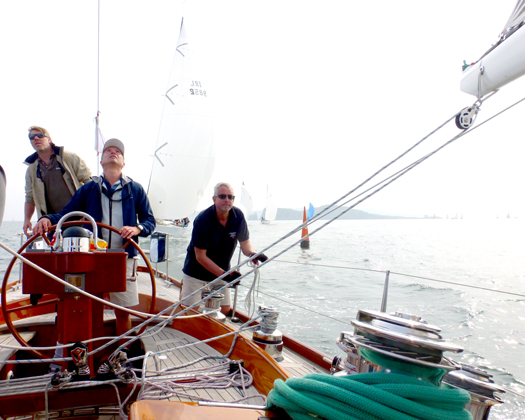
Deflation. We pass the mark at the end of the reach, knowing the run can only mean one thing.......Photo: W M Nixon
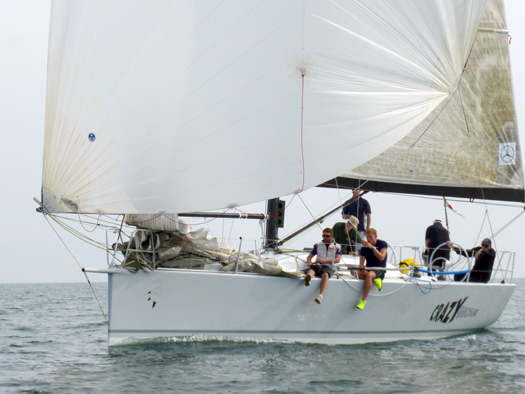
....and with her spinnaker pole deployed, Crazy Horse was soon rolling over us, so we gybed away into what proved to be the light wind side of the leg. Photo: W M Nixon
We rounded the first weather mark vying for the lead on the water with Crazy Horse, and then - mirabile dictu – Soufriere found her mojo and rolled over the Reilly-Chambers boat and led down the short reach to the next turn, but after that it was a wearing dead run with light patches everywhere. Crazy Horse was soon over us again, and as we don't carry a spinnaker pole, we were tacking sharply to lee down the left hand of the run where winds became lighter, while the Horse and Storm went to the right to find a better breeze, and both were ahead at the lee mark.
But then they clearly reckoned they'd used up all the breeze over to the northeast during their success on the run, so for the beat they went to the right where we'd been flat on the run. We meanwhile were left all on our own to do what we wanted, taking a big punt to the left, and it paid in spades. Getting back up to the weather mark, Storm was well astern and we were snapping at Crazy Horse's heels.
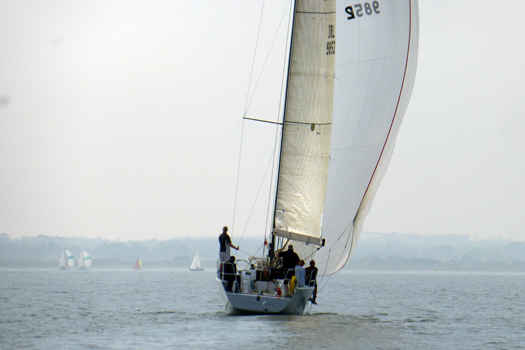
On the second long run, we managed to keep in contact with Crazy Horse.....Photo: W M Nixon
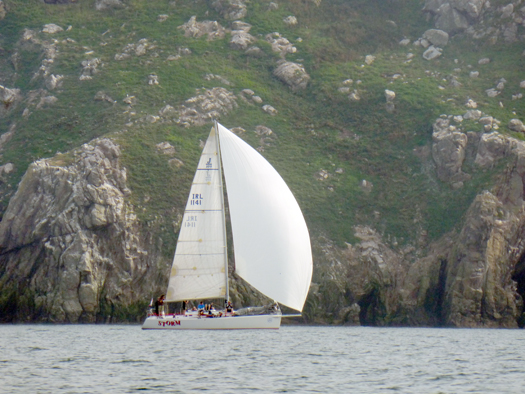
.....while Storm took the scenic route, seeking a private breeze in under the cliffs of Ireland's Eye. Photo: W M Nixon
The next run piled on the pain, but somehow we were hanging in with Crazy Horse, and Storm took a flyer right in under the cliffs of Ireland's Eye. With the wind fading, the Committee Boat had gone over towards Malahide to shorten the course at the lee mark, and a fine selection of the 97 boat fleet were running down together towards it from their various courses.
It made for a very civilised finish time instead of hanging around far into the evening, and we might have hoped for a third or even a second as the long lady which is Soufriere had been doing her very best. But then, just as we neared the finish, didn't the breeze pipe up for a crucial quarter of an hour. We finished at a crisp little speed, but down towards Ireland's Eye the two J/109s and the X332 Equinox were coming up towards the finish with bones in their teeth, and a reasonable chance of a third or even a second for us evaporated to fifth, suddenly three minutes down on the fourth-placed J/109 Dear Prudence (Patrick Cruise O'Brien), while the other J/109 Storm had finished at such speed she pipped Crazy Horse for the win.
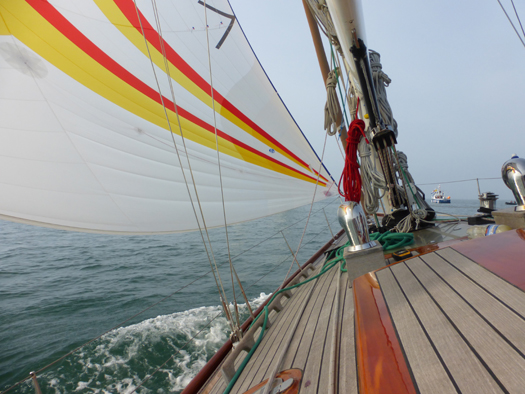
At last a bite to the breeze, but we're just about to finish.......Photo: W M Nixon
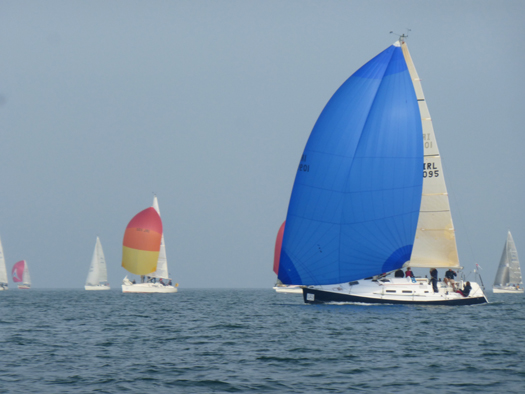
.....so the brief but temporary breeze at the finish brings up the tail-ender Dear Prudence with a bone in her teeth, and Soufriere is pushed back into fifth on CT. Photo: W M Nixon
But that's boat racing. It had been an interesting day in good company, and when she could, the lovely Soufriere rewarded us with competitive performance, at all times with the water tinkling past in that special way it does with a wooden hull. She was a joy to be aboard.
On the 35th Anniversary of the introduction of the Howth Autumn League, it was good to be heading back in the hazy evening sun into this regenerated port where modern facilities are right beside the traditional anchorage. There, the eternally re-born Howth 17s were striking their tops'ls after an afternoon's racing, just as they've always done for 116 years, while continuing with the banter which will go on for ever.
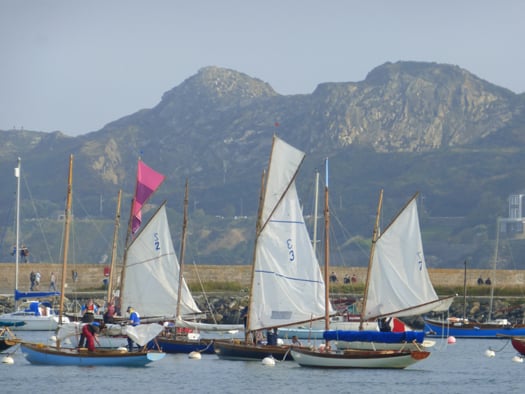
The Howth 17s striking their tops'ls after a Saturday afternoon race, as they have been doing for 116 years. Photo: W M Nixon
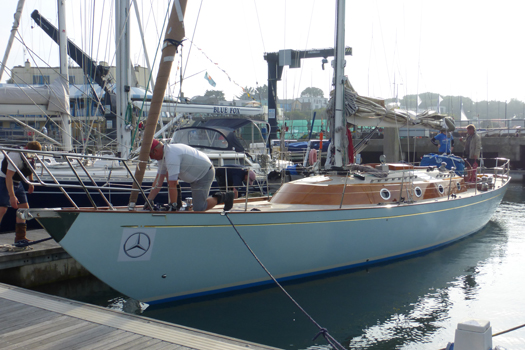
A very likeable boat, and remarkably rewarding to race against more modern types. Soufriere in her berth at Howth after the first race of the MSL Autumn League 2014 at Howth, showing the quality of the work Jimmy Foley of Dun Laoghaire puts into her maintenance. Photo: W M Nixon
Funding Remains Big Issue for Irish VOR Bid
After a struggle to complete the course both financially and on the water in the last Volvo Ocean Race two years ago, Green Dragon is to set sail again if the money can be found to fund a campaign. In this morning's Irish Times David Branigan indicates a potential skipper, Matt Humphries, has been advising the Galway based team but the real problem, as it always has been for the Irish boat, is finding the funding (ten million) to start the race in Spain next year. Full article HERE.



























